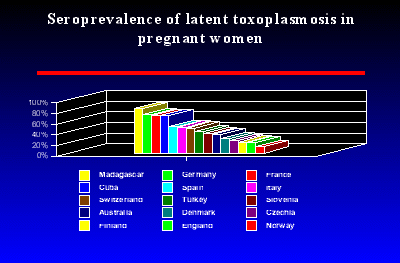Seroprevalence of latent toxoplasmosis in pregnant women


One animal which is frequently infected with T. gondii is the human. The prevalence of toxoplasmosis varies usually between 20-70% depending on the country. In one important respect man is an optimal model for studying the manipulation. While the lifespan of a laboratory rodent has a similar length to the length of acute acquired toxoplasmosis, for human the acute acquired toxoplasmosis usually represents only a mild and short disease. In fact, most of infected people never learn they have met this parasite in the past and carry its dormant stages for the rest of their life. Therefore, the behavioral changes observed in an infected rodent can be the aftereffects of relatively recent acute disease while similar behavioral changes found in a human subject several years after the infection can be more parsimoniously explained as a result of slow cumulative changes induced by manipulative activity of the parasite.


